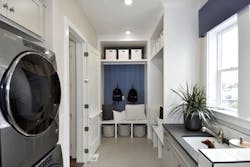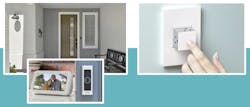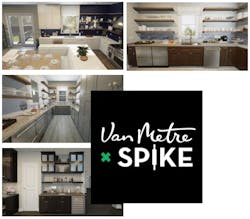With so much change behind us and (no doubt) still ahead, developers and builders are eager need to know what homebuyers will be looking for in the months to come.
Fortunately, the experts at the New Home Trends Institute have put their minds together to identify the 21 trends for 2021. Here’s a rundown of the first nine (in the categories of value, smarter tech, and personalization), with the rest to come in a subsequent post. You can watch the entire 21 Trends for 2021 webinar here (short registration required).
RELATED: 21 Home Design Trends for 2021, Part 2
Trend 1: Frugality is in. That’s about the best value, not the cheapest deal.
“Going out of your way to make sure you’re getting the most value for your money has been almost completely destigmatized,” says Mikaela Sharp, director of the New Home Trends Institute. Seventy-five percent of U.S. consumers say they’re more careful spenders now than a year ago, according to a 2020 OnePoll survey. For one thing, that means the DIY market will thrive.
But frugal doesn’t mean cheap. Frugal shoppers will go the DIY route only within reason. “They know when they’re better off bringing in a professional,” Sharp says. They’ll also invest in services and products, such as energy-regulation technology, that will lead to savings down the line.
Watch Now: 21 Trends for 2021 webinar from the New Home Trends Institute (short registration required)
Trend 2: People are on the move, and they’re after more than homes. They want a lifestyle.
“People are moving in all sorts of ways,” says Ken Perlman, managing principal. Motivated by health and safety concerns and financial prospects, people are moving across state lines, from cities to suburbs, and from apartments to single-family homes.
Developers need to build more than the houses these buyers want. They need to create the lifestyles they crave. That can include amenities such as well-curated parks and open spaces. Master-planned communities must consider “both the physical environment in which people live and what has the most meaning to people in their lives,” Perlman says.
Trend 3: A lot more time spent at home means a lot more need for efficient spaces.
“As we’ve all been stuck in our homes this year, we’ve found that every square foot of space needs to work a little bit harder for us,” says Jenni Lantz, director. Homes will need to include more multipurpose spaces, such as a laundry room that doubles as a mudroom, or an underused hallway that can also serve as a storage space by lining its walls with cabinets.
Trend 4: Buyers will search for their homes virtually—only if builders leverage tech.
The need for social distancing won’t go away overnight. Homebuyers will want to search for their new homes virtually. So developers and builders will have to help them do that. They’ll need to create videos, virtual tours, and even live drone tours of their communities, models, and amenities. For instance, in Dallas, Hillwood Communities offers virtual home shopping on its Find Your New Home, From Home site. Builders also will use live chat and social media to connect with buyers directly.
“Today’s developers are hyper-focused on creating connectivity through public forums like Instagram and Facebook that authenticate the lifestyle and experience of the masterplan, even in social distancing,” Perlman says.
Trend 5: A well-connected home is a well-functioning home.
With more of us working and schooling at home, we’ve had to think about how our homes are (and aren’t) serving our fundamental needs. There’s now one undeniable need, Lantz says: “If you work from home, you need a house where wi-fi can work throughout the whole home.” That’s why the national homebuilder Lennar has introduced what it calls the world’s first Wi-Fi Certified Home Design, ensuring whole-home connectivity.
Trend 6: People want smart tech to help maintain their homes.
This trend has been severely underrated, according to Todd Tomalak, principal. Homeowners want smart maintenance products that detect any potential issues before they become problems, helping their homes to function better. “Embedded sensors in various parts of our home will help us detect maintenance issues early,” Tomalak says. For example, Flo by Moen monitors a home’s entire water supply system, sensing and protecting against leaks. Tomalak sees “a lot of potential” for such products.
Trend 7: Digital is everywhere, and so is digital fatigue. Retro will return.
Many of us work in front of a computer screen all day, then spend much of our downtime in front of screens. “People are fatigued by digital,” says Sharp, who sees “a yearning for a break from tech.”
Consumers will seek out products with a throwback look and feel. For instance, not every smart thermostat has to have the same digital face. At the 2020 International Builders Show, Honeywell displayed a smart thermostat with an old-school dial.
Trend 8: A home’s spaces will be more personalized in more ways.
Personalizing the spaces inside a home won’t simply mean converting a bedroom to a den. “We think there’s an opportunity to explore different options,” Lantz says. She points to Tri Pointe Homes’ Loma at Avance development in Phoenix. Rather than asking homeowners to give up a bedroom to have more living space, it offers a great room with overhead space that can be converted into a private retreat area. So there’s “flexibility without taking away the bedroom count,” Lantz says.
Another example: Van Metre x Spike, by Van Metre Homes, allows homeowners to have an entire chef’s kitchen—or to personalize it by adding and subtracting features, such as an island or pantry, so their kitchen fits their needs.
Trend 9: Manufacturers will close the gap with homeowners.
It used to be that manufacturers were at a far remove from homeowners, with distributors and builders in between. “We’re seeing that relationship begin to close,” Tomalak says.
As part of its Total Home strategy, Lowe’s will offer software so consumers can visualize how products will look in their homes. Similarly, the manufacturer Kohler offers a design service so consumers can design their bathrooms from the comfort of their own homes.
“We think this trend is just beginning and will likely accelerate in future years,” Tomalak says.


